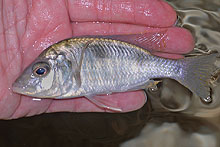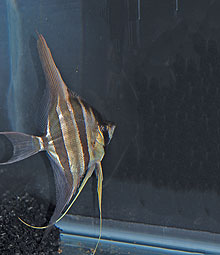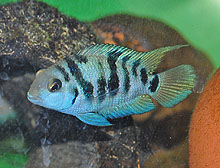WHAT'S NEW ACROSS THE WORLD
Select date in side bar to go to a What's New of previous issues
| What's New
©by Laif DeMason
Winter has been tough this year in many places in the northern hemisphere. Some heavy snowfall here or there, but mostly the extreme bitter cold for weeks has been particularly difficult. Fortunately it has been slowly getting warmer in the USA. Now is the time to re-evaluate your fish set ups and see what is missing. Need fish? Go to a spring fish auction or a local meeting or your local specialty store. See what is different and interesting to keep!
Here’s “what’s new” on the cichlid scene: |
Lake Tanganyika
The strong demand for certain groups of Tanganyika fishes (like wild Tropheus) has been keen for some years. Now there seems to be a pause for those groups while hobbyists find more interesting fish types to keep and breed. For the time being there does not seem to be any overall preference in any particular species or group from this lake.
| WHAT'S NEW: LAKE TANGANYIKA |

An often neglected group of small cave dwelling cichlids are the Telmatochromis species. Not extreme in color; they are more striking with contrasting hues. Here pictured T. vittatus sporting their cream white and black coloration.
|

Something a bit different from the southern Congo coast, first exported in the early 1990s, is this Neolamprologus sexfasciatus. It is not a fully colored gold sexfasciatus but rather a half gold variety found only there, with the gold color concentrated in its dorsum. I don’t think I have ever seen juveniles of this type offered, who knows what they look like! Photo by A. Konings.
|

Requests for wild Cyathopharynx varieties come to me every so often. What most hobbyists do not know is that wild individuals almost never have color since they lose it shortly after capture. Best to buy bred juveniles from a reliable source. Pictured here C. foae from Chimba Zambia. Photo by A. Konings.
|

A fish exported infrequently from Burundi in small numbers in the past is Trematochromis benthicola. This fish has been actually bred from this trickle of wild individuals and are for sale as young. But not for long as the Burundi exporters have been closed down now for two years.
|
Lake Malawi
Concentrated collection and export efforts continue strong on the Tanzania side of the lake; those on the Malawi side not so much as they are still a bit disorganized with overall collections seemingly unsupervised.

While searching and catching infrequent predatory haplochromines over sandy areas, divers sometimes come across large flocks of Lethrinops species not usually found. From Itungi, Tanzania is Tramitochromis sp. ‘orange top’, an incidental catch and thus export! Photo by A. Konings.
|

Another sand dwelling fish from Mdoka, Malawi is Mylochronmis plagiotaenia. Never caught or exported in large numbers, males later develop quite a spectacular coloration. Photo by A. Konings.
|

A new species found from an undisclosed location in Tanzania is now available, two years later, as bred fish. Exported as Otopharynx “ovatus”, this fish is sold as Otopharynx sp. ‘nova blue longnose’ for lack of a better description.
|

Another odd species shipped as Otopharnyx sp. 'jumbo decorus' from Itungi, Tanzania appeared recently. This fish arrived with no color and its true identity is not known for certain but probably is Ctenopharynx pictus from Itungi.
|

One of the big challenges for many years is the breeding of the “Altum” angelfish, Pterophyllum altum pictured here. However, for some time, commercial breeders have offered “Peru Altum” angelfish young which is not the true P. altum as it does not occur in Peru.
|

The Convict cichlid, Amatitlania nigrofasciata hails from a wide area of Central America. In some localities the form varies from the black and white ‘norm’. Pictured here is a blue dwarf type from Rio Danli in Honduras.
|
Select date in side bar to go a What's New of previous issues |









